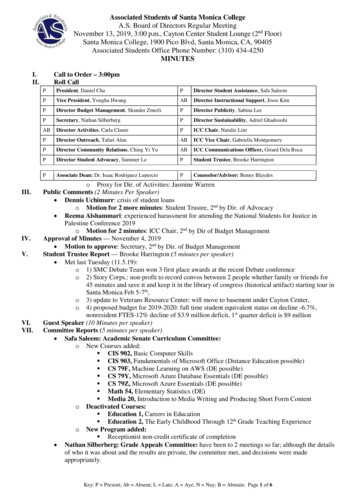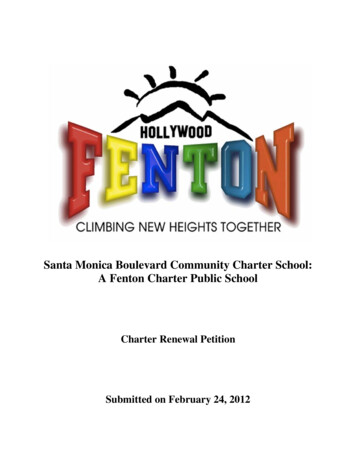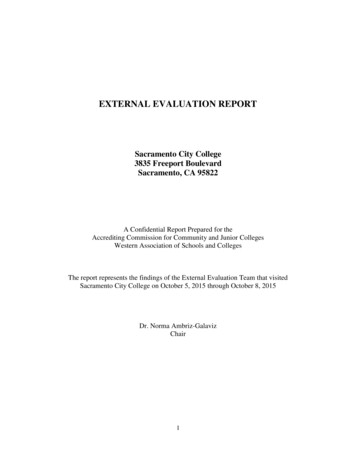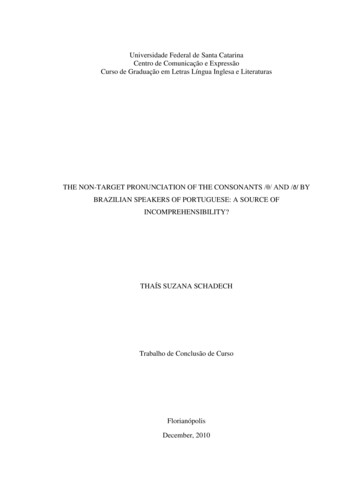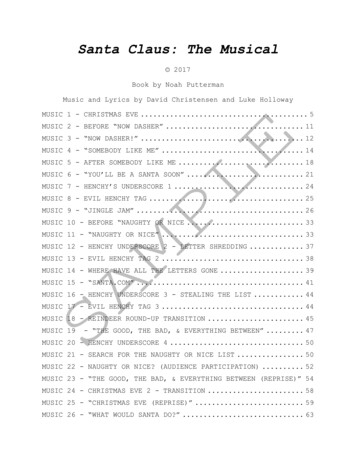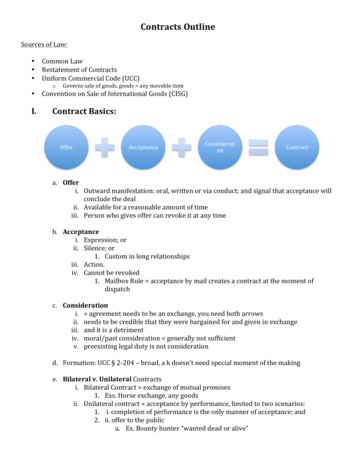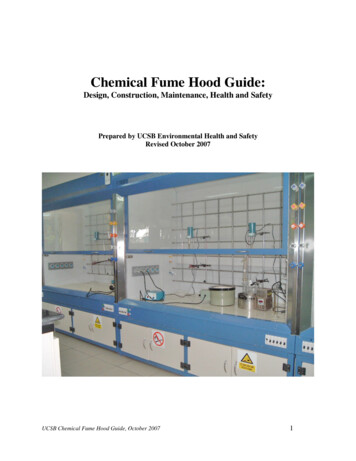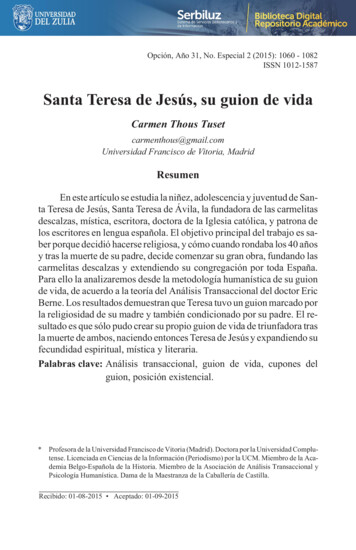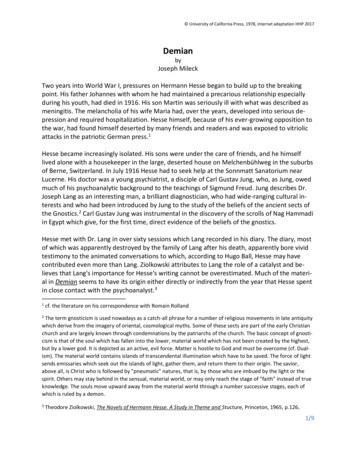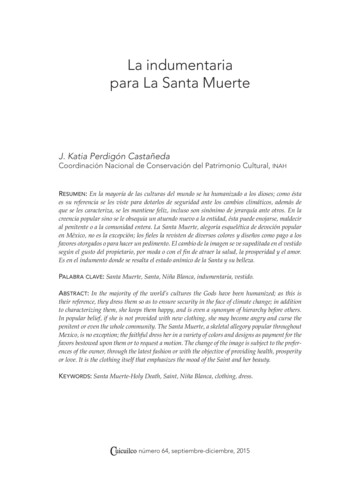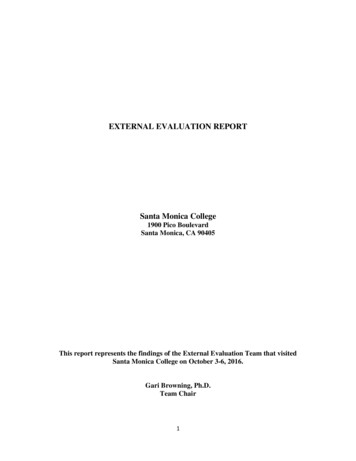
Transcription
EXTERNAL EVALUATION REPORTSanta Monica College1900 Pico BoulevardSanta Monica, CA 90405This report represents the findings of the External Evaluation Team that visitedSanta Monica College on October 3-6, 2016.Gari Browning, Ph.D.Team Chair1
NOTE: this page shall be added to the report noted below, immediately behind the coverpage, and shall become part of the final evaluation associated with the review.DATE:February 3, 2017INSTITUTION:Santa Monica College1900 Pico BoulevardSanta Monica, CA 90405TEAM REPORT:External Evaluation Team Report (Team Report)This report represents the findings of the evaluation team that visited Santa Monica CollegeOctober 3-6, 2016.SUBJECT:Commission Revisions to the Team ReportThe Team Report provides details of the team’s findings with regard to the EligibilityRequirements, Accreditation Standards, and Commission policies, and should be read carefullyand used to understand the team’s findings. Upon a review of the Institutional Self-EvaluationReport (ISER) and evidentiary materials submitted by Santa Monica College and the TeamReport, the following changes or corrections are noted for the Team Report:1. The Commission has clarified the Standard citations in Recommendation 4 and deletedStandard citation I.C.5 from the recommendation wherever it occurs in the Team Report.2. The Commission has removed Recommendations 2 and 3 wherever they occur in theTeam Report.3. The Commission has added the following recommendation for improvement:Commission Recommendation 2: In order to increase effectiveness, the college needs tocomplete the migration of its course data to ensure that all course outlines and syllabiinclude student learning outcomes. (Standard II.A.3)2
LIST OF TEAM MEMBERSChairMs. Sally PestanaProfessor of Health Sciences, HealthEducation Non-credit DirectorKapiolani Community CollegeDr. Gari BrowningPresident/SuperintendentOhlone CollegeAssistantMs. Melissa ReeveInstructor, English & ESLSolano Community CollegeMs. Shairon ZingsheimAssociate Vice President, HR and TrainingOhlone CollegeDr. Gregory SouthDean, Student LearningCollege of the SiskiyousAcademic RepresentativesMs. Stephanie CollierProfessor of MathematicsCollege of the SequoiasAdministrative RepresentativesMr. Jeff CummingsSuperintendent/PresidentCopper Mountain CollegeDr. Charles BradenDean, Fine and Performing ArtsAmerican River CollegeMr. Dennis GordonActing Director of Outreach and PlanningIrvine Valley CollegeMr. John JohnstonProfessor, Philosophy & EnglishCollege of the RedwoodsMs. Jennifer HughesVice President Student ServicesCollege of San MateoDr. Alfred KonuwaExecutive Vice President Academic andStudent AffairsWoodland Community CollegeOther RepresentativesResearchMr. Alfred GallegosDean of Institutional AdvancementLos Angeles Southwest CollegeMr. Peter HepburnHead LibrarianCollege of the CanyonsBaccalaureate SpecialistDr. Denis WrightCharlotte Campus PresidentFlorida South Western State College3
INTRODUCTIONINSTITUTION:Santa Monica CollegeDATE OF VISIT:October 3-6, 2016TEAM CHAIR:Gari Browning, Ph.D.President/Superintendent, Ohlone Community College DistrictThe visit of the External Evaluation team was conducted from October 3-6, 2016. Prior to thevisit, the team chair and team assistant conducted an in-person pre-visit to the College to arrangelogistics and address any issues that required in-person attention. On the first day of the visit,members of the team visited the facilities and personnel at the five off-campus sites near themain campus.Although about half of the fifteen-member team had external team experience, members wereconscientious and quick learners. All prepared well prior to the visit, coalesced quickly into aneffective team, and were thorough in their assessment of the College. The ACCJC team wascomplemented by an experienced evaluator of baccalaureate degrees from Florida South WesternState College.Santa Monica College was among the early colleges to use the 2014 Accreditation Standardsand Eligibility Requirements and Quality Focused Essay. The 400-page self-evaluation reportwas complete, well organized, easy to read, and well supported with easily accessible evidenceembedded throughout. The report addressed all Standards, Eligibility Requirements, ACCJCPolicies, USDE requirements, financial data and evidence, and requirements of the SubstantiveChange 6-Month Site Visit for Baccalaureate Degrees.Determination of how the College was operating within the Standards was based on review ofthe self evaluation report, examination of evidence available through links in the report, filesavailable on a college-supplied USB drive, as requested during the visit, interviews withmembers of the College community, observations of meetings, and the teams’ notes andassignments from their careful reading of the self evaluation report.4
RECOMMENDATIONS OF THE 2016 VISITING TEAMRecommendations to meet the StandardsRecommendation #1:In order to meet the Standards, the team recommends the College incorporate into itsmission statement a clear description of its intended student population. (I.A.1)Recommendation #2:In order to meet the Standards, the team recommends the College complete development ofStudent Learning Outcomes for all courses offered, ensure that in every class sectionstudents receive a course syllabus that includes learning outcomes from the institution’sofficially approved course outline, and implement an ongoing cycle of learning outcomeassessment for courses, student services, and administrative units in order to improveprogram outcomes. (I.A.2, I.B.2, I.B.4, I.B.5, I.C.1, I.C.3, II.A.3, II.C.2, ER 11, ER 19)Recommendation #3:In order to meet the Standards, the team recommends the College develop and implementa comprehensive cycle of continuous quality improvement that monitors, assesses, andrecommends improvements to the function and effectiveness of its processes, committees,and planning cycles. (IV.A.7)Recommendation #4:In order to meet the Standards, the team recommends the College create a schedule toregularly review Board policies and regulations to assure integrity in all representations ofthe college mission, programs, and services. (I.C.5, IV.C.7)Recommendation #5:In order to meet the Standards, the team recommends the Board follow its policiesregarding delegation of authority related to the president/superintendent and ensure thepresident/superintendent is able to implement and administer Board policies withoutBoard interference in college operations. (IV.C.7, IV.C.12)Recommendation #6:In order to meet the Standards, the team recommends that the College resolve thediscrepancies regarding the baccalaureate degree and publish the accurate number of totalunits and minimum number of upper division units required to complete the program inall appropriate documents and publications. (I.C.1, II.A.5, II.A.12, ER 10)Recommendations to increase institutional effectivenessRecommendation #7:In order to increase institutional effectiveness, the team recommends the College improvethe college community’s ability to interpret and utilize data to inform effective decisionmaking. (I.A.2, I.B.4, I.B.8, II.C.2)5
Recommendation #8:In order to increase institutional effectiveness, the team recommends the College establishand implement assessment of the effectiveness of its governance structures and processes.The assessment should extend to communication protocols related to planning andgovernance, particularly its consistent communication across all employee groups regardingDPAC recommendations to the superintendent/president. (IV.A.2, IV.A.6, IV.A.7, IV.B.3)TEAM COMMENDATIONSCommendation #1:The team commends the College for implementing online educational plans, conductinginformative studies in collaboration with IT regarding student contact with counselors and itsimpact on student achievement, and establishing its counseling internship program to ensure anadequate applicant pool of qualified counselors.Commendation #2:The team commends the College for its creative efforts to solve student transportationchallenges.Commendation #3:The team commends the College for its outstanding job of increasing safety on the campus inlight of the 2013 incident and for devoting financial resources to increase preventative safetymeasures.Commendation #4:The team commends the College for its high level of student engagement and its participation incivic activities.Commendation #5:The team commends the College for implementing systematic processes to address technologyneeds, for developing home-grown IT systems to support student achievement and institutionalimprovement, and for demonstrating the flexibility needed in technology to account for changingcircumstances such as the development of the baccalaureate program.Commendation #6:The team commends the College for its attention to accessibility in technology and particularlyfor providing one-on-one training and consultation to students with disabilities.Commendation #7:The team commends the College for addressing recommendations of the College actuarial planto set aside 3.8 in one-time funding and establishing an irrevocable trust to provide for futureobligations.Commendation #8:6
The team commends the College for its innovative approach to ensuring that SMC is safe anddiscrimination free and that complaints of all types are handled swiftly and confidentially.7
ELIGIBILITY REQUIREMENTS1. AuthoritySanta Monica College (SMC) is a public, two-year community college and has providedevidence that it is authorized by the State of California under the authority of the Board ofGovernors of the California Community Colleges. The College is an authorized post-secondaryeducational institution to award degrees through the Accrediting Commission for Communityand Junior Colleges (ACCJC) of the Western Association of Schools and Colleges (WASC).The College also provided evidence that it has received initial accreditation status from ACCJCfor the baccalaureate degree in Interaction Design.The College meets this requirement.2. Operational StatusThe College is fully operational, with students actively attending classes, studying, andparticipating in all the expected activities in pursuit of their degrees. Interviews with studentsverified that they are pursuing both associate degrees and the baccalaureate degree.The College meets this requirement.3. DegreesSMC offers associate’s degrees, certificates, and one bachelor’s degree. A review of the CollegeCatalog verified that courses and support programs and services are designed to lead students todegree attainment. The majority of the institution’s students are enrolled in courses leading to adegree.The College meets this requirement.4. Chief Executive OfficerSMC has a superintendent/president who serves as the institution’s chief executive officerappointed by the governing board, with full-time responsibility to the institution. Thesuperintendent/president possesses the requisite authority to administer board policies. She doesnot serve as chair of the Board of the Board of Trustees. The institution informs the Commissionimmediately when there is a change in the institutional chief executive officer.The College meets this requirement.5. Financial AccountabilityThe College undergoes annual audits conducted by a certified public accountant employed by anexternal firm. The institution demonstrates compliance with federal requirements.The College meets this requirement.8
Checklist for Evaluating Compliance withFederal Regulations and Related Commission PoliciesPublic Notification of an Evaluation Team Visit and Third Party CommentEvaluation Items: The institution has made an appropriate and timely effort to solicit third party comment inadvance of a comprehensive evaluation visit. The institution cooperates with the evaluation team in any necessary follow-uprelated to the third party comment. The institution demonstrates compliance with the Commission Policy on Rights andResponsibilities of the Commission and Member Institutions as to third partycomment.[Regulation citation: 602.23(b).]Conclusion Check-Off (mark one): The team has reviewed the elements of this component and has found the institutionto meet the Commission’s requirements. The team has reviewed the elements of this component and has found the institution tomeet the Commission’s requirements, but that follow-up is recommended. The team has reviewed the elements of this component and found the institution does notmeet the Commission’s requirements.Narrative (add space as needed):In the preparation for its 2016 Accreditation Self Evaluation, Santa Monica College engaged in atwo-year process that encouraged participation by members from across the college community.The College has a long-standing record of compliance with the Accrediting Commission asevidenced by the more than 60 years of timely submission of accreditation self-studies,responsiveness to accreditation concerns and recommendations, and positive accreditationreviews.See Standards I.C.1 and I.C.2, page 26.Standards and Performance with Respect to Student AchievementEvaluation Items: The institution has defined elements of student achievement performance across theinstitution, and has identified the expected measure of performance within each definedelement. Course completion is included as one of these elements of student achievement.Other elements of student achievement performance for measurement have been9
determined as appropriate to the institution’s mission. The institution has defined elements of student achievement performance within eachinstructional program, and has identified the expected measure of performance within eachdefined element. The defined elements include, but are not limited to, job placement ratesfor program completers, and for programs in fields where licensure is required, the licensureexamination passage rates for program completers. The institution-set standards for programs and across the institution are relevant toguide self-evaluation and institutional improvement; the defined elements and expectedperformance levels are appropriate within higher education; the results are reportedregularly across the campus; and the definition of elements and results are used in programlevel and institution-wide planning to evaluate how well the institution fulfills its mission, todetermine needed changes, to allocating resources, and to make improvements.The institution analyzes its performance as to the institution-set standards and as to student achievement, and takes appropriate measures in areas where its performance is notat the expected level.[Regulation citations: 602.16(a)(1)(i); 602.17(f); 602.19 (a-e).]Conclusion Check-Off (mark one): The team has reviewed the elements of this component and has found the institution tomeet the Commission’s requirements. The team has reviewed the elements of this component and has found the institution tomeet the Commission’s requirements, but that follow-up is recommended. The team has reviewed the elements of this component and found the institution does notmeet the Commission’s requirements.Narrative (add space as needed):SMC has established institution-set standards for satisfactory performance of student success,including course completion, that are published in the Institutional Effectiveness Dashboard andthe annual ACCJC report. The College assesses how well it is achieving the institution-setstandards, and when achievement metrics fall below the institution-set standards the Collegefollows its process to address the finding.The College has established institution-set standards for student achievement in the InteractionDesign program but has not, due to the newness of the program, assessed or published them.The College has a proactive planning and informed decision-making process to ensure thatfinancial resources are sufficient to support and sustain student learning programs and servicesand improve institutional effectiveness. The College has internal control systems to ensurefinancial integrity and meets required state and federal reporting guidelines.See Standard I.B.3, pages 21-22.10
Credits, Program Length, and TuitionEvaluation Items: Credit hour assignments and degree program lengths are within the range of good practicein higher education (in policy and procedure). The assignment of credit hours and degree program lengths is verified by the institution, andis reliable and accurate across classroom based courses, laboratory classes, distanceeducation classes, and for courses that involve clinical practice (if applicable to theinstitution). Tuition is consistent across degree programs (or there is a rational basis for any programspecific tuition). Any clock hour conversions to credit hours adhere to the Department of Education’sconversion formula, both in policy and procedure, and in practice.The institution demonstrates compliance with the Commission Policy on InstitutionalDegrees and Credits.[Regulation citations: 600.2 (definition of credit hour); 602.16(a)(1)(viii); 602.24(e), (f); 668.2; 668.9.] Conclusion Check-Off (mark one): The team has reviewed the elements of this component and has found the institution tomeet the Commission’s requirements. The team has reviewed the elements of this component and has found the institution tomeet the Commission’s requirements, but that follow-up is recommended. The team has reviewed the elements of this component and found the institution does notmeet the Commission’s requirements.Narrative (add space as needed):The College uses the Carnegie System of Units to determine units of credit to be awarded foreach course, including courses offered online. These policies conform to commonly acceptedpractice regarding course content and time invested. Units of credit awarded are consistent withinstitutional policies that reflect generally accepted norms or equivalencies in higher education.Policies and procedures related to the awarding of credit via the Carnegie Unit system are thesame for the upper division courses that comprise the Bachelor of Science in Interaction Designas they are for lower division courses. The awarding of academic credit, the B.S. degreerequirements, and transfer policies all conform to commonly accepted practice regarding coursecontent and time invested. Tuition is established by the state on a per-unit basis for all collegesin the California Community College system.The College awards credit based on generally accepted practices. It does not convert clock hoursto credit hours. The College also follows the California Community College Chancellor’s OfficeStandard Formula for Credit Hour Calculations. Policies are presented in the College Catalog.See Standard I.A.9, pages 45 and 73.11
Transfer PoliciesEvaluation Items: Transfer policies are appropriately disclosed to students and to the public. Policies contain information about the criteria the institution uses to accept credits fortransfer.The institution complies with the Commission Policy on Transfer of Credit. [Regulation citations: 602.16(a)(1)(viii); 602.17(a)(3); 602.24(e); 668.43(a)(ii).]Conclusion Check-Off (mark one): The team has reviewed the elements of this component and has found the institution tomeet the Commission’s requirements. The team has reviewed the elements of this component and has found the institution tomeet the Commission’s requirements, but that follow-up is recommended. The team has reviewed the elements of this component and found the institution does notmeet the Commission’s requirements.Narrative (add space as needed):Through reviews of the college catalog, administrative regulations, curriculum committeedocuments, and interviews with college personnel, the team established that the College makesavailable to its students clearly stated transfer-of-credit policies.See Standards I.C.1, I.C.2, II.A.1, and II.A.10, and pages 25-26, 33, 39-40, 50, and 72-73.Distanc
Feb 03, 2017 · Ohlone College Academic Representatives Ms. Stephanie Collier Professor of Mathematics College of the Sequoias Dr. Charles Braden . informative studies in collaboration with IT regarding student contact with counselors and its impact on student achievement, and establ
